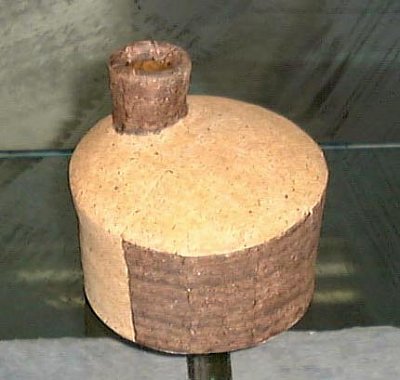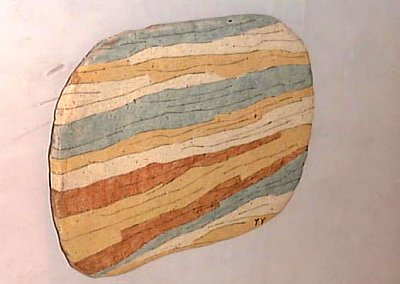|

Yellin's gallery
sells pieces from
the kilns of Japan's
finest potters
|
|
|
Exhibition Review
Yoshimura Toshimi
at Yufuku Gallery in Tokyo
November 1 to 10, 2001
Tel: 03-5411-2900 Fax: 03-5411-2901
|
Pastel colors and tones of the earth are the color schemes that Aomori-based potter Yoshimura Toshimi chooses to work with.
Gentle purples, sandy beiges, and dull yellows dance lightly over his cheesecloth-impressed works. Subdued and minimal in a Zen way, Yoshimura's simple forms are a refreshing change from all the traditional yakishime ones that abound in Japan.
Yoshimura recently exhibited at Yufuku in Tokyo and the modern ambience of the gallery was another good match for Yoshimura's humble work. Yufuku is small but with its mirror and glass interior the illusion of a wider space is created.
This can be a bit unnerving for some though as reflections are created that can make a visitor feel a bit off balance (see below).
The way the staff display the work is never off-balance and all the exhibitions I've been to are eloquently arranged.
Sitting smartly on glass counter-tops surrounded by stone, the works looked quite comfortable in the mixed-media arrangement. Three small covered monotone boxes sat next to a zigzag striped covered pot and I found that unusual; Japanese almost always use odd numbers for mixing and matching.
The boxes were charming and I could imagine playing a modern version of the shell game with them.
Opposite this group was a large dull yellow vase that had two black 'beckoning cats' in its shadow.
All of Yoshimura's work is hand built and the warmth of that method comes out in the linear forms. Four such pots were lined up on a sidewall and one couple was having the hardest time figuring out which one to take home. I believe they chose the one on the far right.
One piece I thought was outstanding was this stately square-shoulder jar with a jigsaw puzzle like middle in those soft and inviting pastel tones. It sat in front of a clouded piece of glass that offered an ethereal feeling to its rooted form.
Next to it stood a grouping of the tallest works. Banded, striped, solid, or in a patchwork style, they displayed the gentle spirit that must fill Yoshimura's heart. I thought the two artlessly inserted branches were not needed and actually distracted from the works.
Together they formed a classic grouping and I wonder how one would fend for itself all alone. I have my doubts that the work would stand and make a statement in solitude. Like a piece of tofu on a plate without the garnishments of ginger or sliced scallions, it's not complete. I imagine that the same can be said for a single Yoshimura austere work as well. Almost all of the pieces did better in conjunction with another or others.
This small piece was an exception.
 |
It had a soothing presence in its form and colors that would be a quieting piece to gaze on just before retiring for the evening. A perfect size for a side table, it is a visual haiku that I found in some, but not many of Yoshimura's work. His chawan forms didn't suit his decorative schemes and would have been better off left out of the exhibition.
Also on display were some wall hangings that looked like cut glass, abbreviated kanji, or stratified earth. They were pleasant enough but I wish he hadn't awkwardly signed his initials in such a prominent fashion on the lower right of each piece. It was too much of a distraction.
 |
 |
Yoshimura was born in 1949 in Ibaraki prefecture. He studied in Kasama starting in 1977 before establishing his kiln in the snow country of Aomori. His work has been accepted for the Asahi Ceramic Exhibition (1986), Chunichi International Ceramic Exhibition (1987), and the Japan Ceramic Exhibition (1989) among others. He was also awarded the Yagi Kazuo Prize at the Contemporary Ceramic Exhibition in both 1988 and 1989.
story by Robert Yellin
LEARN MORE
- Yufuku Gallery Exhibition of Yoshimura Toshimi's Work
Opens new window in your browser.
|
|
|
|
|